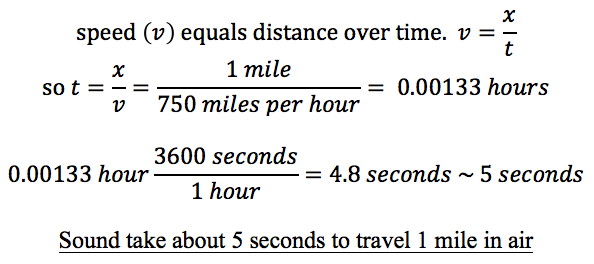Students explore the speed of sound by experiencing the delay for sound to reach them when they know a noise has been made. They will explore what it feels like to identify objects from a distance.
Science Topics
Echoes
Echolocation
Speed of sound
Process Skills
Observing
Predicting
Scientific inquiry
Comparing
Classifying
Communicating
Grade Level
1-12
Preparation
None
Set-Up
15 minutes
Activity
45 minutes*
Clean-Up
10 minutes
Learning Goals
Students will be able to:
- Describe that there is a delay between when they see a sound happen and when they hear it
- Name several animals that use echolocation and SONAR to find food or objects
- Describe the limits of the size and distance that dolphins and bats can echolocate
Materials not in Kit
Additional supervision*
A very large field, 200 yards or bigger (twice the size of a football field)
A rock and Metal post (such as a fence post)
7 different objects
6 landscaping flags (or other markers)
Set-Up
- Label the 7 different objects with numbers 1-7.
- Set up the field with landscaping flags (or other eco-friendly markers) every twenty large paces (or every 20 meters) from the metal pole until you reach 100 meters, then place the last maker at the 200-meter mark.
- Leave that rock, and 7 objects next to the metal post.
Introduce the Activity
Students will answer question 1 in their packets to get them thinking about the speed of sound. Explain that the class will be going outside for the remainder of the activity. You should also identify any safety concerns that may exist.
Doing the Activity
Speed of Sound
- The class will travel to the field set up with the markers. Have the students stay 200 feet away from the metal post.
→ Ask the class why you think you can see fireworks before you can hear the boom.
- Have an assistant walk to the metal post that’s 200 meters away from the rest of the class (the length of two football fields).
NOTE: It’s very important to be this far away to show the delay of sound. We tried 100 meters and the delay wasn’t large enough.
- With a large, visible arm motion, the assistant will strike the metal post with a rock. The assistant should do this at least 10 times. It’s helpful to prearrange a signal for the assistant to know when to stop hitting the post.
- Discuss the following questions with the class:
→ Do you hear the sound at the same time that you see the rock hit the post? → Why do you think this is? → How can you tell how far away lightening is?
- Briefly demonstrate the calculation for the speed of sound. The speed of sound in air in Colorado is about 750 miles per hour. Calculate how many seconds it takes sound to travel 1 mile (time = distance/speed).
 This is where the rule of thumb comes from that says for every five “one-thousands” that you count, the lightening is a mile away from you.
This is where the rule of thumb comes from that says for every five “one-thousands” that you count, the lightening is a mile away from you.
Identification from a Distance
- Students should go to a point that is 100 meters away from the metal post, halfway across the field. They should each have the Identification from a Distance chart (page 2 of their packet) and a writing utensil.
- Explain that at this distance – using echolocation – a dolphin can identify small fish just 6 inches in length and some bats can identify a certain type of moth with a 1.25-inch wingspan!
- While the students are still 100 meters away, the assistant will hold of the 7 objects one at a time, in order. Students will look at each object and try to discern what each one is and write down their best guess on the chart, even if it’s just the color. After they have done this for all 7 objects from 100 meters away, students will up to the 80-meter mark and repeat the process. Then the same for 60 meters, 40 meters and 20 meters. The assistant should hold up the 7 objects in the same order each time.
- As soon as the students think they know for sure what the objects are, they will circle the word in their chart under that distance.
For example, they figure out object 1 is a fish at 40 meters, circler the word “fish” in the 40- meter column.
Fish Finding Game
- Groups of 8-10 students will work together for this activity. One student will be a dolphin, 3 will be fish, and the rest will be objects
• The dolphin must keep their eyes closed the whole time.
• Objects are to lay, sit or stand in one place.
• Fish move around slowly, winding in and out of objects. - The dolphin tries to locate fish while avoiding objects
• The dolphin makes a sound, “beep,” and any object or fish in front of the dolphin is required to respond.
→Objects will say, “object”
→Fish will say, “fish”
• When a Fish is tagged, that fish becomes a dolphin, and the dolphin becomes a fish.NOTE: If the dolphin is having trouble locating fish, or if the fish are misbehaving, have the fish move one step per beep or have them stand still.
- After playing the game, students should answer questions 7 and 8.
Key Lesson Terminology
Echoes – reflections or repetitions of sound waves. Echoes can be produced and heard by clapping hands or shouting in a large empty room with hard walls or in a cave for example.
Echolocation – a method used to detect objects by producing a specific sound and listening for its echo.
Speed of Sound – the speed at which sound travels. This is very important for scientists who study sound. In air, sound travels 343 meters in 1 second (747 miles per hour), but in water, sound travels 1500 meters in 1 second (3350 miles per hour). compare these speeds to cars traveling on the highway at 65 miles per hour.
SONAR – Sound Navigation And Ranging, is the process of listening to specific sounds to determine where objects are located.
Optional Extensions
If there is extra time, students can switch roles in the Fish finding game and play from a new perspective.
Modifciations
Hard of hearing students will not be able to tell the difference between when they see the rock hit and when the sound reaches the class, so other students could raise hands when they hear the sound. This way the student can still tell that there is a difference between when a sound is created and when it reaches a specific location.
For younger students, it isn’t necessary to fill out the worksheets as they complete the activity.
